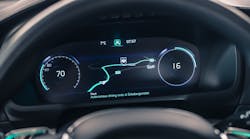Autonomous test cars are Frankensteins. Each vehicle is stuffed full of servers and sensor pods are mounted to the roof. But the computing power in these vehicles will have to be condensed and streamlined before they actually enter production.
Today, an average car is programmed with around 100 million lines of code as opposed to 50 million in the Large Hadron Collider, and that number could keep growing in driverless cars. Much of that code runs on more than 100 electronic control units, each handling a single function from windshield wipers to automatic braking.
Now Elektrobit has announced a new software line that makes it easier for engineers to condense all that code into a handful of multicore chips. With it, the company, whose software powers 70 million vehicles worldwide, aims to lay the groundwork for harnessing high-performance controllers to run infotainment and self-driving systems.
The software, EB corbos, will not be released until the first quarter next year but it offers some insight into the programming of self-driving cars. It spans three products, and the first is called AdaptiveCore, which provides basic code to enable wireless updates over a vehicle’s lifetime and faster communications between electronic control units.
The product is Elektrobit’s interpretation of a new standard called Adaptive Autosar, which underlies basic software used in driverless car controllers and makes programming them easier. It stems from another standard, Classic Autosar, which targets electronic control units that perform a single task like firing an engine’s spark plug.
These systems typically rely on tiny microcontrollers, which is “very different from where we are headed,” said Walter Sullivan, who leads Elektrobit’s Silicon Valley laboratory, in a recent phone interview. “We are now developing much more dynamic systems.”
For autonomous highway driving, cars needs separate systems for adaptive cruise control, front-facing cameras, and automatic lane-keeping, in addition to sensors that take stock of the car’s surroundings. These controllers could be located on opposite sides of the vehicle but need to send instructions in real-time to make split-second decisions to avoid accidents.
“Each of these systems exists in cars today, but they are not integrated in any way. For cars to actually drive themselves, these parts need to operate together. A natural first step would be to combine them in one box,” said Sullivan, adding that these systems will require new and formidable silicon from chipmakers like Nvidia and Intel’s Mobileye unit.
Elektrobit, based in the German city of Erlangen, is trying to lower the bar for programming these chips. The EB corbos line also includes a hypervisor that allows camera and radar systems, for instance, to run simultaneously on different cores in the same chip. That prevents software failures from cascading between systems, improving safety and reliability.
The third piece of software is a custom version of the Linux operating system. It is optimized to boot faster when paired with the hypervisor, which like the other EB corbos products is sold separately. Reducing the number of controllers embedded in cars saves money that can be reinvested in more expensive processors, said Sullivan.
Elektrobit, a subsidiary of auto parts supplier Continental, competes for software sales with Vector and Mentor Graphics. The first Autosar standard was drafted in 2004 by multinational automakers including Volkswagen and Ford. It was created as a way to provide reliability more consistently and lower the development cost of new cars.
Sullivan said that Classic Autosar would not vanish overnight. Using it, basic software can be swapped out, for example, of an air conditioning unit from General Motors and reused in a windshield wiper system inside a Ford. The first permutation of Adaptive Autosar will be released in the first half of next year.
Sullivan estimates that it could take another 10 to 20 years before these multifunctional chips become the norm. Instead of installing new electronic control units, automakers need to start using software updates to enable new functions like blind spot warnings and customize cars for different geographic regions, Sullivan said.
Electric car companies like Tesla, which first used over-the-air updates, could move faster than legacy automakers. These start-ups also have technological motivations: Fewer electronic control units also means less wiring needed to connect them. Today, wiring harnesses can weigh almost half a ton, hurting the range of battery-powered vehicles.
Waymo – the driverless car unit of Google parent Alphabet – and other companies like Apple could parlay their expertise in data centers and smartphones into self-driving and infotainment systems, he said. “The concepts being looked at are actually coming from data centers,” said Sullivan, who was previously a senior automotive program director at Microsoft.

